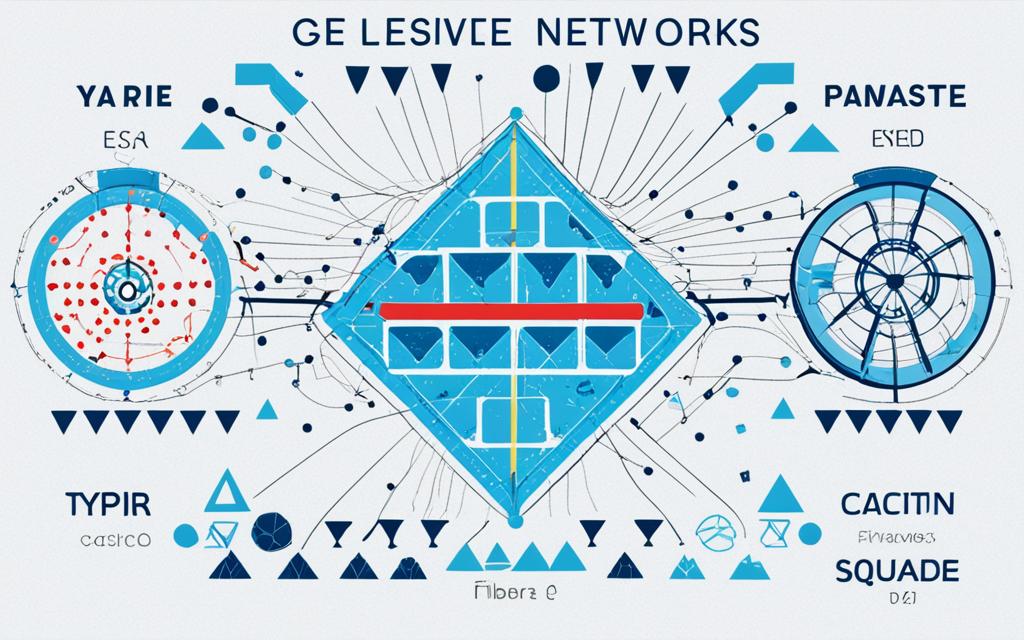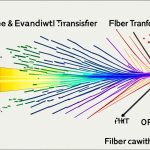In today’s fast-paced digital world, reliable and high-speed internet connectivity is essential for both individuals and businesses. One technology that has revolutionized the way data is transmitted is Passive Optical Networks (PON). PONs utilize fiber optic cabling to bring lightning-fast internet directly to the end user, resulting in increased bandwidth and improved efficiency.
Passive Optical Networks consist of two main components: the Optical Line Terminal (OLT) located at the central office and the Optical Network Units (ONUs) placed near the end users. The transmission in a PON is entirely passive, meaning it doesn’t require power or active electronic parts. This efficient infrastructure eliminates the need for additional Ethernet cables and reduces the overall complexity of the network.
PONs can be deployed in various scenarios, including fiber to the curb, fiber to the building, or fiber to the home, providing high-speed internet connectivity to residential, commercial, and industrial areas. Different types of PONs, such as GPON, EPON, and 10G-PON, offer different speeds and capacities to meet the diverse needs of users.
One of the key advantages of PONs is their cost-effectiveness. By utilizing passive optical splitters, PONs allow multiple users to share the same fiber connection, reducing the overall infrastructure costs. Additionally, PONs provide enhanced security due to the lack of electrical signals emanating from the end user premises, ensuring data privacy and protection.
However, it’s important to note that PONs require extensive fiber deployment and have distance limitations due to the nature of the passive transmission. These factors need to be taken into account when planning and implementing PON systems.
In conclusion, Passive Optical Networks offer a highly efficient and reliable solution for delivering high-speed internet connectivity. With their seamless integration of fiber optic cabling, PONs provide enhanced bandwidth, cost-effectiveness, and increased security. As the demand for fast and reliable internet continues to grow, PONs are poised to play a pivotal role in shaping the future of broadband connectivity.
What is a Passive Optical Network?
A Passive Optical Network (PON) is a telecommunications system that utilizes fiber optic cabling to deliver signals directly to the end user. PONs can be configured to provide fiber connectivity to various termination points, such as the curb, a building, or even a residential home. These networks consist of an Optical Line Terminal (OLT) located at the central office and multiple Optical Network Units (ONUs) strategically positioned near the end users.
The key differentiating factor of a PON is its passive transmission method, which means it operates without the need for power or active electronic components. This stands in contrast to active optical networks that rely on electrically powered switching hardware. By leveraging the passive nature of the network, PONs offer several advantages in terms of performance, security, and cost-effectiveness.
Passive Optical Network architectures, such as fiber to the curb (FTTC), fiber to the building (FTTB), and fiber to the home (FTTH), extend the reach of fiber optic connections, enabling faster and more reliable data transmission compared to traditional copper-based networks. This advanced technology contributes to better user experiences, especially in bandwidth-intensive applications like streaming, video conferencing, and gaming.
“A PON provides a cost-effective and efficient solution for delivering high-speed broadband services over long distances, addressing the growing demands of modern communication.”
In a PON, the OLT acts as the central point of control, transmitting data signals through the fiber optic infrastructure to the ONUs. These ONUs are responsible for converting the optical signals into electrical signals usable by the end-user devices. The entire network operates on a point-to-multipoint architecture, allowing a single OLT to serve multiple ONUs simultaneously.
PONs have revolutionized the telecommunications industry by providing improved bandwidth capacity, reduced signal loss, enhanced security, and greater flexibility compared to traditional copper-based networks. Additionally, PONs offer the potential for significant cost savings, as they require less maintenance, are more energy-efficient, and can be easily upgraded to accommodate higher speeds and increased network demands.
As the demand for high-speed internet and reliable connectivity continues to rise, the deployment of Passive Optical Networks is expected to grow rapidly. The versatility and scalability of PONs make them well-suited for various applications, including residential broadband, business connectivity, mobile network backhaul, and smart city integration.
How Does a Passive Optical Network Work?
In a Passive Optical Network (PON), an Optical Line Terminal (OLT) at the central office transmits signals to multiple Optical Network Units (ONUs) near the end users. The transmission across the network is passive, meaning it requires no power or active electronic parts.
“The term ‘passive’ describes the fact that once the signal is being transmitted, there are no power requirements or active electronic parts.”
This is in contrast to active optical networks, which rely on electrically powered switching hardware. PON systems offer high-speed optical transmission without the need for active components throughout the network.
Working Mechanism of a Passive Optical Network
- At the central office, the Optical Line Terminal (OLT) converts electrical signals into optical signals, which are then transmitted over fiber-optic cables to the Optical Network Units (ONUs) near the end users.
- The Optical Network Units (ONUs) receive the optical signals and convert them back into electrical signals that can be used by the end user’s devices.
- The transmission across the network is passive, meaning it relies on the reflective properties of the fiber-optic cables and the passive splitters to direct the signals to the appropriate ONUs.
- There is no active electronic processing or switching of the signals along the way, which contributes to the efficiency and reliability of PON systems.
The diagram below illustrates the working mechanism of a Passive Optical Network:
By eliminating the need for active electronic components throughout the network, PON systems are cost-effective and require less maintenance. Additionally, the use of fiber cabling enables high-speed optical transmission, making PONs suitable for various applications, such as residential broadband, business connectivity, and mobile network backhaul.
Types of Passive Optical Networks
Passive Optical Networks (PON) come in various types, each offering different theoretical capacities and bandwidths. Bandwidth limitations in PONs are determined by the electrical overlay, which manages connections and determines capacity.
The first commercially deployed PON systems were APON or BPON, with downstream capacities of 155 Mbps or 622 Mbps. These systems used ATM or cell switching protocols.
One widely deployed PON system is GPON, which supports various speeds. GPON systems can achieve symmetrical speeds of 622 Mbps and download capacities of up to 2.5 Gbps, with upload capacities of 1.25 Gbps.
Another type of PON is EPON, an Ethernet-based system that includes 10G-PON. EPON offers higher speeds compared to traditional PON systems.
The Next-Generation PON2 standard is currently in development and is expected to reach speeds of up to 80 Gbps. This advancement in PON technology will provide even faster and more efficient networks.
Comparison of PON Types
| Type | Theoretical Capacity | Upstream Bandwidth | Downstream Bandwidth |
|---|---|---|---|
| APON/BPON | Up to 622 Mbps | 155 Mbps | 155 Mbps |
| GPON | Up to 2.5 Gbps | 1.25 Gbps | 2.5 Gbps |
| EPON/10G-PON | Up to 10 Gbps | 1.25 Gbps | Up to 10 Gbps |
| Next-Generation PON2 | Up to 80 Gbps | TBD | TBD |

Table: Comparison of PON Types with Theoretical Capacity, Upstream Bandwidth, and Downstream Bandwidth.
Benefits and Limitations of PONs
Passive Optical Networks (PONs) offer several benefits that make them a popular choice for broadband delivery technologies. However, they also have some limitations that need to be considered in network planning and implementation.
Benefits of PONs
PONs provide the following advantages:
- Cost-effectiveness: PONs offer a cost-effective solution for deploying high-speed broadband networks, making them an attractive option for service providers.
- No need for electrically powered midspan devices: Unlike other broadband technologies, PONs do not require electrically powered midspan devices, reducing operational costs and simplifying network infrastructure.
- Use of existing fiber optic infrastructure: PONs can be implemented using existing fiber optic infrastructure, minimizing the need for additional infrastructure investment.
- Ample upgrade paths: PONs support various upgrade paths, allowing service providers to enhance network capacity and performance as demand grows.
- Secure broadband technology: PONs are considered a secure broadband technology, providing a robust and reliable connection for end-users.
Limitations of PONs
While PONs offer many benefits, they also have limitations that should be taken into account:
- Extensive fiber deployment: Implementing PONs requires extensive fiber deployment, which can be a significant investment and time-consuming process.
- Management traffic overhead: In larger networks, the management traffic overhead in PONs may become a limiting factor, potentially reducing overall network efficiency.
- Transport distance limitations: PONs have transport distance limitations compared to active powered network technologies, which may restrict their use in certain geographical areas.
Despite these limitations, PONs remain a popular choice for broadband delivery due to their cost-effectiveness, secure technology, and ability to leverage existing fiber optic infrastructure.

| Benefits of PONs | Limitations of PONs |
|---|---|
| Cost-effectiveness | Extensive fiber deployment |
| No need for electrically powered midspan devices | Management traffic overhead |
| Use of existing fiber optic infrastructure | Transport distance limitations |
| Ample upgrade paths | |
| Secure broadband technology |
PON Standards and Development History
PON technologies play a crucial role in telecommunication networks and are standardized and developed by reputable organizations such as the International Telecommunication Union – Telecommunication Standardization Sector (ITU-T) and the Institute of Electrical and Electronics Engineers (IEEE). These organizations guide the development and standardization of PON technologies, ensuring compatibility, interoperability, and global industry standards.
Over the years, PON standards have evolved significantly, progressing from early technologies like APON (ATM PON) and BPON (Broadband PON) to more advanced systems such as GPON (Gigabit PON), XGSPON (10 Gigabit Symmetric PON) and NG-PON2 (Next Generation PON 2). These advancements have brought about increased speeds, improved efficiency, and enhanced capabilities to meet the growing demands of modern PON networks.
Early PON Technologies: APON and BPON
“Early PON technologies, such as APON and BPON, laid the foundation for the development of more advanced systems. These technologies utilized ATM (Asynchronous Transfer Mode) and cell switching protocols to enable high-speed data transmission over fiber optic networks.”
APON, also known as ADSL PON (Asymmetric DSL PON), offered downstream capacities of 155 Mbps and employed ATM cells for data transmission. BPON, on the other hand, enhanced the downstream capacity to 622 Mbps, providing higher speeds for residential and business broadband services.
GPON: Advancements in PON Technology
“GPON revolutionized the PON landscape with its increased bandwidth and flexibility. It became the most widely deployed PON technology, supporting various speeds and configurations.”
GPON (Gigabit PON) raised the bar for PON systems by offering symmetrical speeds of up to 2.5 Gbps for downstream and 1.25 Gbps for upstream transmission. This improvement in speed and capacity allowed for enhanced broadband services, including high-definition video streaming, online gaming, and cloud-based applications.
Next-Generation PON: XGSPON and NG-PON2
“Next-Generation PON technologies, such as XGSPON and NG-PON2, are poised to push the boundaries of PON capabilities to meet the ever-increasing demand for high-speed and reliable connectivity.”
XGSPON (10 Gigabit Symmetrical PON) builds upon the success of GPON and enables symmetrical speeds of up to 10 Gbps. This advancement opens up new possibilities for bandwidth-intensive applications, such as virtual reality (VR) and augmented reality (AR).
NG-PON2 (Next Generation PON 2) is currently in development and expected to deliver speeds of up to 80 Gbps. This standard will provide unprecedented capacity and flexibility, making it ideal for future technologies like 5G, Internet of Things (IoT), and smart cities.
Comparing PON Technologies
| PON Technology | Downstream Capacity | Upstream Capacity |
|---|---|---|
| APON | 155 Mbps | 155 Mbps |
| BPON | 622 Mbps | 155 Mbps |
| GPON | 622 Mbps – 2.5 Gbps | 155 Mbps – 1.25 Gbps |
| XGSPON | 10 Gbps | 10 Gbps |
| NG-PON2 | Up to 80 Gbps | Up to 80 Gbps |
Table: Comparison of PON Technologies and Their Capacities
The table above presents a comparison of various PON technologies, showcasing their respective downstream and upstream capacities. As technologies continue to evolve, PON standards will continue to push the boundaries of fiber-optic networks, enabling faster and more reliable connectivity.
PON Components and Characteristics
In Passive Optical Networks (PONs), a combination of passive and active components work together to facilitate efficient data transmission. The passive components, namely optical fibers and splitters, form the foundation of PONs. On the other hand, active devices such as Optical Line Terminals (OLTs) and Optical Network Units (ONUs) play crucial roles in initiating and managing data flow.
Optical fibers act as the medium for transmitting data by converting electrical signals into optical signals. They are designed to minimize signal loss and provide high-speed and reliable connections. Splitters, which are passive optical devices, divide the optical signal into multiple paths without the need for active components or power. This allows for point-to-multipoint communication within the PON architecture.
Optical fibers and splitters serve as the backbone of PONs, enabling efficient and widespread data transmission.
The active devices in PONs include OLTs and ONUs. OLTs are located at the central office and act as the main interface between the PON and the wider network. They initiate and manage the transmission of data from the network to the ONUs connected to the end-user premises. ONUs, situated near the end users, receive the optical signals transmitted by OLTs and convert them into electrical data that can be understood by the end-user devices.
To handle both downstream and upstream traffic efficiently, PONs utilize a technology called wavelength division multiplexing (WDM). This technology allows multiple signals to be transmitted simultaneously over different wavelengths, maximizing the bandwidth capacity of the PON. As a result, PONs are capable of supporting high-speed data transmission in both directions, ensuring efficient communication for various applications.
Encryption and security features are integral components of PONs, ensuring data integrity and privacy. These features protect the transmitted data from unauthorized access and enhance the overall security of the network.
Network Architecture
The network architecture of PONs follows a point-to-multipoint configuration. A single OLT serves multiple ONUs, allowing for efficient data distribution to different end-user premises. This architecture enables cost-effective deployment by minimizing the number of active components required and simplifying the network management process.
Components of a PON
| Component | Description |
|---|---|
| Optical Fiber | A medium for transmitting optical signals, converting electrical signals to optical signals |
| Splitters | Divides optical signals into multiple paths without active components or power |
| OLTs | Optical Line Terminals situated at the central office, initiate and manage data flow |
| ONUs | Optical Network Units near end-user premises, convert optical signals to electrical data |
Conclusion
Passive Optical Networks (PONs) are revolutionizing the telecommunications industry with their efficient fiber-optic network infrastructure and point-to-multipoint architecture. By utilizing wavelength division multiplexing (WDM), PONs enable the transmission of data at high speeds and with reliable connectivity.
The applications of PONs are vast, ranging from providing high-speed residential broadband and seamless business connectivity to facilitating mobile network backhaul and integrating with smart city initiatives. As we witness the rapid advancement of technologies such as 5G and the Internet of Things (IoT), PONs will continue to play a crucial role in meeting the demand for fast and reliable data transmission.
Looking ahead, the future of PONs holds great promise. Integration with emerging technologies, further advancements in WDM, and the development of next-generation PON standards will shape the telecommunications landscape. PONs are poised to deliver enhanced connectivity, greater scalability, and improved efficiency, ensuring they remain at the forefront of transforming the way we communicate and access information.
FAQ
What is a Passive Optical Network (PON)?
A Passive Optical Network (PON) is a telecommunications system that uses fiber optic cabling to bring signals to the end user. PONs can be deployed for various purposes, including fiber to the curb, fiber to the building, or fiber to the home. They consist of an Optical Line Terminal (OLT) at the central office and multiple Optical Network Units (ONUs) near the end users. The transmission in a PON is passive, meaning it requires no power or active electronic parts.
How does a Passive Optical Network (PON) work?
In a Passive Optical Network (PON), the Optical Line Terminal (OLT) at the central office transmits signals to multiple Optical Network Units (ONUs) near the end users. The transmission across the network is passive, meaning it requires no power or active electronic parts. The term “passive” describes the fact that once the signal is being transmitted, there are no power requirements or active electronic parts. This is in contrast to active optical networks, which require electrically powered switching hardware. PON systems offer high-speed optical transmission without the need for active components throughout the network.
What are the types of Passive Optical Networks (PON) available?
There are several types of Passive Optical Networks (PON) available, including GPON, EPON, and 10G-PON. These different types of PONs offer different speeds and capacities. GPON is a widely deployed PON system that supports various speeds, ranging from 622 Mbps symmetrical to 2.5 Gbps download and 1.25 Gbps upload capacities. EPON, including 10G-PON, is an Ethernet-based PON that provides higher speeds. The Next-Generation PON2 standard is in development and expected to achieve speeds of up to 80 Gbps.
What are the benefits and limitations of Passive Optical Networks (PON)?
Passive Optical Networks (PONs) offer several benefits, such as cost-effectiveness, security, and long-distance transport capabilities. They also use existing fiber optic infrastructure and have ample upgrade paths. PONs can be transported over relatively long distances, making them suitable for network trunk uplink purposes. However, PONs require extensive fiber deployment, larger networks can become less efficient due to management traffic overhead, and they have transport distance limitations compared to active powered network technologies.
What are the standards and development history of Passive Optical Networks (PON)?
PON technologies are standardized and developed by organizations such as the International Telecommunication Union – Telecommunication Standardization Sector (ITU-T) and the Institute of Electrical and Electronics Engineers (IEEE). These organizations guide the development and standardization of PON technologies. Over time, PON standards have evolved, from early technologies like APON and BPON to more advanced systems like GPON, XGSPON, and NG-PON2. These standards have brought increased speeds, efficiency, and capabilities to PON networks.
What are the components and characteristics of Passive Optical Networks (PON)?
Passive Optical Networks (PONs) consist of passive components like optical fibers and splitters, along with active devices like Optical Line Terminals (OLTs) and Optical Network Units (ONUs). Optical fibers and splitters are the passive building blocks of PONs, dividing the optical signal into multiple paths without the need for power or active components. OLTs initiate and manage the data flow, while ONUs convert optical signals into electrical data at the end-user premises. PONs utilize wavelength division multiplexing (WDM) to handle downstream and upstream traffic efficiently. PONs also offer encryption and security features, ensuring data integrity and privacy. The network architecture of PONs is point-to-multipoint, with a single OLT serving multiple ONUs.
How are Passive Optical Networks (PON) relevant in telecommunications?
Passive Optical Networks (PONs) have a wide range of applications, from residential broadband and business connectivity to mobile network backhaul and smart city integration. As technologies like 5G and the Internet of Things (IoT) continue to evolve, PONs will play a crucial role in providing high-speed and reliable connectivity. The future of PONs will involve integration with emerging technologies, advancements in wavelength division multiplexing (WDM), and the development of next-generation PON standards. With their efficiency and scalability, PONs are poised to reshape the telecommunications landscape.



















